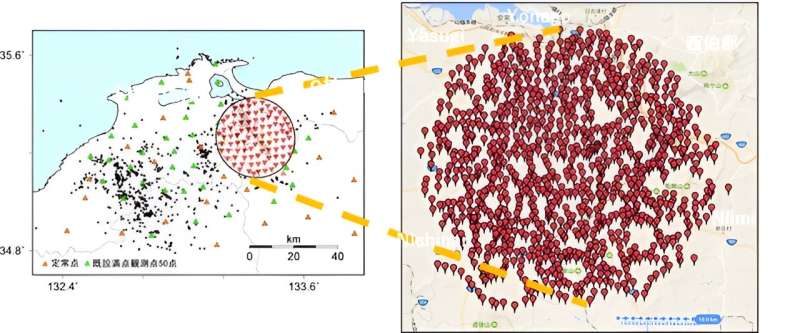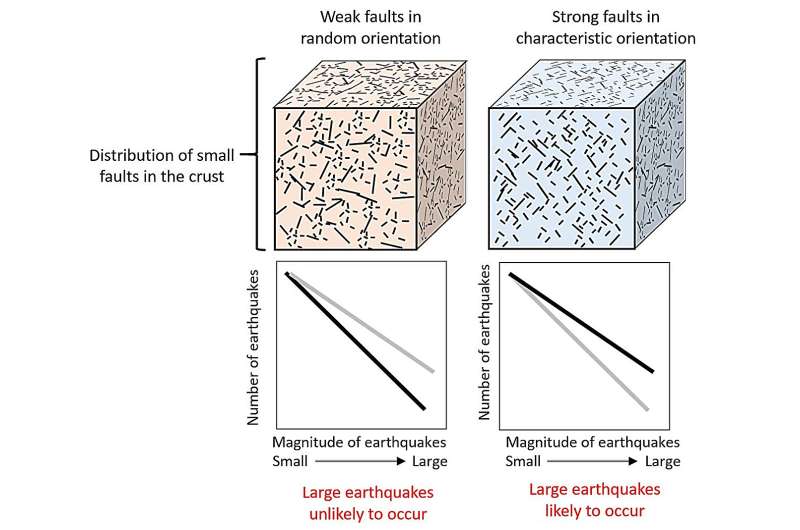This article has been reviewed according to Science X's editorial process and policies. Editors have highlighted the following attributes while ensuring the content's credibility:
fact-checked
peer-reviewed publication
trusted source
proofread
Most detailed study yet of seismic activity links fault strength to likelihood of large earthquakes

Located on the Pacific Ring of Fire, Japan is one of the most earthquake-prone countries in the world, with thousands of small earthquakes occurring each year, and the continuous threat of a "big one." Currently, predicting when major earthquakes will occur isn't possible, but by studying the numerous small earthquakes that occur, seismologists in Japan hope to understand more about the processes in the Earth's crust that lead to major quakes.
Now, researchers from Kyushu University and the University of Tokyo, Japan, have studied seismic activity at an unprecedented level of detail, identifying a link between fault strength and earthquake magnitude. Published in Nature Communications, the study proposes that the strength of the fault affects the b-value—and therefore the likelihood of a major earthquake.
"The b-value is a very important constant in seismology that characterizes the relationship between earthquake frequency and size," explains Professor Satoshi Matsumoto, first author of the study and the Director of Kyushu University's Institute of Seismology and Volcanology. "If there is a low b-value, this means there is a higher proportion of large earthquakes, while a high b-value means there is a higher proportion of smaller earthquakes."
The b-value can vary between different locations and also over time, and is often reported to decrease just before a major earthquake. A previous study suggested that the decrease in b-value was caused by the increasing stress forces exerted on the fault. Now, this study suggests that fault strength is also a contributing factor.
In the study, the research teams analyzed the seismic action happening in the area around the epicenter of the Western Tottori Earthquake, which occurred in 2000 with a magnitude of 7.3. By installing more than 1,000 seismic stations in the area, the researchers could conduct seismic observations with an unprecedented level of accuracy.
"Even two decades on, hundreds of tiny aftershocks still occur, most too small for us to feel," says Matsumoto.

With so many sensors, the researchers could detect tiny movements of the faults, and also the orientation of each fault within the Earth's crust.
Using this multitude of data, the team was able to estimate the stress field (the different directions of stress forces exerted on each fault at the time of failure) and allowed them to characterize the faults as strong or weak.
"Under certain stress conditions on each tectonic regime, there is a favorable direction of the fault plane to slip. When faults are in unfavorable directions, this suggests that these are weak faults that can slip more easily. On the other hand, strong faults require more stress to slip, and have a much more characteristic direction," explains Matsumoto.
From the stress field calculations, the researchers were also able to estimate the b-value of the event group categorized by fault strength. They found that stronger faults have smaller b-values, suggesting that large earthquakes are more likely to occur, while weaker faults had larger b-values, suggesting that major earthquakes are less likely.
"Simply put, these weak faults will likely slip before a large amount of stress builds up, which means that they aren't able to release a large amount of force," says Matsumoto.
Through deeper understanding of the factors that impact b-values, the researchers hope that they will be able to inch closer to the "holy grail" of predicting earthquakes.
"I don't think we will ever know exactly when an earthquake will strike, but looking at data such as fault direction and fault strength, and calculating b-values, could help us estimate when a fault has reached a critical point— where just a tiny extra nudge of force is needed for the fault to slip," concludes Matsumoto. "This information is vital to know in order to be prepared for major earthquakes."
More information: Satoshi Matsumoto et al, Strength dependency of frequency–magnitude distribution in earthquakes and implications for stress state criticality, Nature Communications (2024). DOI: 10.1038/s41467-024-49422-7
Journal information: Nature Communications
Provided by Kyushu University





















